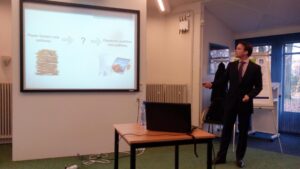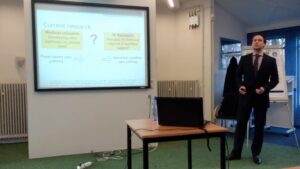On Tuesday, 3/12/2013, Wesley van Renswouw has defended his master thesis on deriving Workflow Management Support from Care Pathway Protocols.
Supervisors TU/e:
- Dr. P.M.E. Van Gorp, TU/e, Information Systems
- Dr. O. Türetken, TU/e, Information Systems
Supervisor Philips Research:
Management Summary
Nowadays there are major issues in the healthcare related to quality, performance and costs. Even in countries where the healthcare is well developed and resourced there is clear evidence that the quality remains a serious concern. Too many errors and incidents happen in the clinical working practices, resulting in unnecessary suffering, use of resources, and even deaths. In the USA at least 210,000 deaths each year are a result of preventable hospital errors. In National Health Service hospitals in the UK this number is estimated on 40,000 deaths a year due to medical errors. On top of that the cost of healthcare is increasing each year. It is clear that something has to change in the way healthcare is currently practising its business.
In the 1980s care pathways were introduced for the first time. A care pathway is a description of a care process from an organization point of view for a specific disease and for a specific group of patients. It is based on evidence and on (clinical) guidelines and it is designed to improve efficiency and patient outcomes. The aim of care pathways is to enhance the quality of care across the continuum by improving risk-adjusted patient outcomes, promoting patient safety, increasing patient satisfaction, and optimizing the use of resources. That this aim is getting achieved is demonstrated by many studies on this subject. Using care pathways can significantly improve the quality of care, shorten the length of stay of a patient, and lower the costs of care.
However the majority of care pathways that are developed and implemented are used manually by filling predefined paper documents. In this day and age where other industries have adopted workflow management systems with e.g. automated tasks, decision support, and compliance checking, the usage of paper-based documents seems obsolete. The few studies that are performed
on workflow applications that integrate the care pathways show promising results. Key performance indicators like quality of care, length of stay of patient, use of resources, and costs of care are improved by these new systems.
As mentioned these systems are still in development and mature systems are not yet widely introduced and adopted in the market. The current mismatch between medical research and research done within the field of Information Systems might be the problem. Where the medical research is aimed primarily at developing the care pathways on a clinical level, the research in the
Information Systems field is mainly focused on specific technical aspects of implementing care pathways into executable workflow applications. The part which describes how text-based care pathways can be modelled into executable workflow process models in a structured way is still missing in current research. Therefore in this thesis a methodology is derived which can be followed to transform paper-based care pathways to executable workflow process models in a structured and reproducible way.
The intention behind this methodology is to increase the usability of and compliance with care pathways in the healthcare field. By using the steps proposed in this methodology it is easier for hospitals and industrial partners to develop workflow process models based on paper-based care pathways. Also the developed process models will have a similar structure which would make the models more understandable in the long run since stakeholders will recognise the structure of the models.
The methodology consists of three phases. In phase one the paper-based care pathway is annotated in order to extract the information that is presented in the paper-based care pathway.
Phase two describes the steps how the annotated paper-based care pathway can be modelled in a conceptual process model in a structured and reproducible way. First the sunny day scenario is modelled in the main process. Next the subprocesses are modelled. It is likely that there are multiple child levels in the process model; therefore it is important to follow the structured approach, given in the methodology, to get a consistent model. Business rules should be added in order to comply with the procedures stated in the care pathway. Next extended BPMN constructs and exception handling patterns can be used to model the variance that can occur in the care pathway.
Finally the third phase provides a step-by-step description on how to perform the transformation from a conceptual process model to an executable workflow process model. Topics that are included in these steps are: the soundness and correctness of the conceptual model, the link between the two modelling languages, adjusting the conceptual model, modelling the required data, flexibility, roles and users, forms, business rules, integration with health information systems, and verification and execution of the process.
In order to give a proof of concept the methodology is used in a case study which uses the paper-based unstable angina care pathway as starting point. This care pathway is distributed by the Chinese Ministry of Health and its use is mandatory for all Chinese hospitals. In this case study first the care pathway is annotated. Next the whole case pathway is modelled to a conceptual model. In the last phase a section of the conceptual model is transformed to an executable workflow model.
An internal evaluation by Philips Research states that the annotation phase is an essential step in the methodology because it helps the modeller to get better acquainted with the care pathway he/she wants to model. The annotation steps provide a deeper understanding of information and the structure of the care pathway. The conceptual model is quite suitable for clinical practice and particularly useful for understanding the care pathway and communicating the necessary details among the relevant stakeholders. However the case study performed on the third phase of the methodology is quite limited; therefore the executability of the workflow process model should be tested more extensively and the outcomes should be communicated with the stakeholders before the real value of this phase can be determined. Also the intended use of the workflow process model needs to be further investigated.
Thesis Text
Available from the TU/e library
Pictures from the Thesis Ceremony





